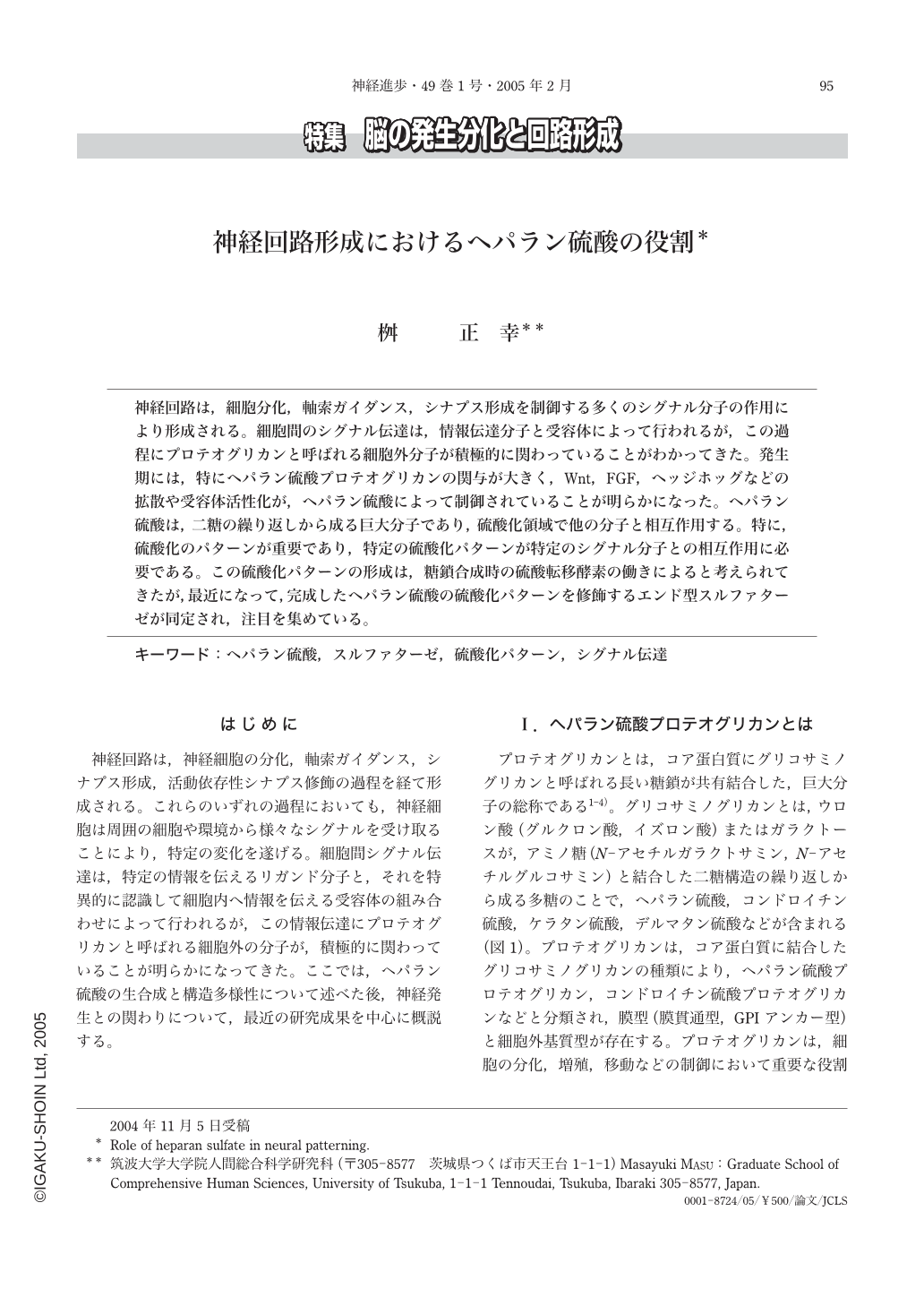Japanese
English
- 有料閲覧
- Abstract 文献概要
- 1ページ目 Look Inside
神経回路は,細胞分化,軸索ガイダンス,シナプス形成を制御する多くのシグナル分子の作用により形成される。細胞間のシグナル伝達は,情報伝達分子と受容体によって行われるが,この過程にプロテオグリカンと呼ばれる細胞外分子が積極的に関わっていることがわかってきた。発生期には,特にヘパラン硫酸プロテオグリカンの関与が大きく,Wnt,FGF,ヘッジホッグなどの拡散や受容体活性化が,ヘパラン硫酸によって制御されていることが明らかになった。ヘパラン硫酸は,二糖の繰り返しから成る巨大分子であり,硫酸化領域で他の分子と相互作用する。特に,硫酸化のパターンが重要であり,特定の硫酸化パターンが特定のシグナル分子との相互作用に必要である。この硫酸化パターンの形成は,糖鎖合成時の硫酸転移酵素の働きによると考えられてきたが,最近になって,完成したヘパラン硫酸の硫酸化パターンを修飾するエンド型スルファターゼが同定され,注目を集めている。
Neural circuits are formed through the steps of neural differentiation, axon guidance, synapse formation, and activity-dependent refinement of synaptic connections. These processes are regulated by the actions of many signaling molecules in the extracellular space. Accumulating evidence from genetic, biochemical, and cell biological studies revealed that heparan sulfate proteoglycans play an important role in neural development. For example, the Drosophila mutants for the genes encoding heparan sulfate synthesizing enzymes showed the phenotypes similar to those of the mutants of Wnt, FGF, and hedgehog, indicating that heparan sulfate is necessary for the signal transduction of these molecules. Indeed, heparan sulfate proteoglycans have been shown to regulate the diffusion and receptor activation of these signaling molecules. Heparan sulfate is a long unbranched sugar chain composed of the disaccharide repeats of glucuronic acid(or iduronic acid)and glucosamine. There are mainly three possible sulfated positions in the disaccharide units, and sulfation occurs at these positions unevenly, thus creating very complicated microheterogeneity in the long chain. The highly-sulfated region, called S-region, is involved in the interaction with other molecules, and specific sulfation patterns are implicated in the complex formation with specific ligands. It is generally believed that these variable sulfation patterns are generated by the combined actions of four classes of heparan sulfate sulfotransferases, although the molecular mechanisms which regulate such pattern generation remains to be unknown. Recently, novel sulfatases(termed SulfFPs or Sulfs)that can modify heparan sulfate microstructure have been isolated and attracted attention in terms of the modulation of extracellular signal transduction. SulfFP protein is localized in the Golgi apparatus and endoplasmic reticulum but not in lysosomes, and is also secreted into extracellular space and associated with cell surface. SulfFPs have endosulfatase activity that removes the sulfate moiety from the 6-O-position in the glucosamine in intact heparin at neutral pH, which is in contrast to the function of the conventional sulfatases that degrade glycosaminoglycans at acidic pH in lysosomes. Thus these data suggest the possibility that SulfFPs can modulate the heparan sulfate-mediated extracellular signaling by modifying heparan sulfate microstructure. Although in vitro studies revealed that SulfFPs are necessary for the activation of Wnt and FGF, further studies will be necessary in order to elucidate the physiological function of SulfFPs in vivo.

Copyright © 2005, Igaku-Shoin Ltd. All rights reserved.


